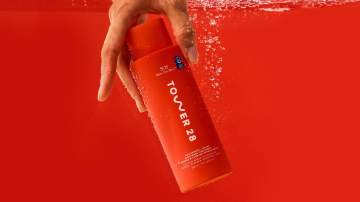Sensing her clients were tightening their budgets in the last few years, Sherman Oaks-based hair stylist Cara Feder began offering quicker cut and color services at more affordable prices. In 2025, those smaller services have become particularly attractive.
“I started offering what I call the ‘root and run.’ So you just come in and I throw base color on for mostly gray-coverage clients, and then they run out after I wash them, no blow dry,” she said. “It felt natural to offer, since I did have some people say, ‘Oh, I don’t need a blow dry.’ I think it was maybe people trying to save money.”
Offering those smaller services, she believes, has helped her keep her books full at a time when many consumers are looking for ways to trim their budgets. According to the University of Michigan’s March 2025 Survey of Consumers, consumer sentiment fell 11.9% from February and 28.2% from March 2024, with respondents across the political spectrum believing an economic downturn will impact their personal finances and business decisions. A March Glossy research report found that 57% of consumers permanently switched to cheaper store brands.
And those sentiments are showing up in how consumers are thinking about their hair. According to data from Launchmetrics, the media impact value for keywords “recession hair,” “recession blonde” and “recession brunette” grew 96% from February to March.
“I can say with quite definitiveness that we are in an economic downturn, and we see it in our salon,” said David Thurston, co-founder and CEO of professional hair-color brand Danger Jones and Los Angeles’s Butterfly Loft Salon and Spa. “We talk to our labs, who are creating hair color for all the different brands, and they’re all reporting a downturn.”
Social media users have identified looks like “recession blonde” as a grown-out blonde look when keeping up pricey bleaching services becomes too costly. While the specific term may be a blip in the fast-turning social media cycle, its rise is indicative of how consumers are already shaping their beauty choices to new economic realities.
“The recession blonde and recession indicators being a new TikTok thing is almost a new ‘lipstick index,’” said Lisa Payne, head of beauty at trend forecaster Stylus. While consumers may rethink some of their spending, she said they are more likely to look for value in their beauty purchases than cut them out altogether.
“People are walking away if something is not at the right price or the right value,” she said. “That’s not to say the beauty industry, in general, needs to quake in its boots. It’s more about [consumers] finding more value in what they’re spending. The post-Covid spending and purchasing dopamine hit is hitting differently right now.”
To think about bringing value to its audience of professional hair stylists, Danger Jones took a radical approach: lowering prices. In January, the company lowered the price of its Danger Jones Premium Powder Lightener from $30 to $23, and its corresponding developer by $2.
“We also know the idea of a loss leader, meaning you can lose money on the printer if you can make money on the ink that you sell,” said Thurston. “So if we can help stylists out, perhaps our company could win.” In the five weeks after the price reduction, Thurston said Danger Jones saw a 27% increase in units of the lightening products sold, compared to the five weeks before.
But the prices of beauty products across the industry are now in a state of uncertainty. On Wednesday, President Trump announced a sweeping set of tariffs that would impose as high as 49% fees on goods entering the U.S. from countries such as Vietnam, China and E.U. countries.
Feder said she has held off on raising her prices, which she typically does each fall, in anticipation of how tariffs may impact the cost of her materials. Danger Jones’s founders are also keeping the conversation on pricing fluid with their distributors and suppliers.
“The truth is that, in situations like this, you try not to come up with anything that’s too permanent,” said Thurston. “So the idea of passing [the costs] on to the stylist doesn’t sit well with me, particularly since [tariffs] are reversible.”
The impacts of the new tariffs on beauty habits are yet to be seen. But even in difficult economic periods, Thurston said clients rarely cut out their hair care altogether.
“There are a lot of things that people will give up before [their hair services] — that’s probably the last thing to go,” he said. “That might be the situation where the most desperate callout is, ‘I can’t afford that anymore,’ and that’s where they need to consult with their stylist to come up with a transition. And that is the name of the game during these economic downturns.”
Feder said she still sees clients who want the big transformation, like going platinum blonde, but they may not maintain a high-cost blonde color for as long as they used to, instead transitioning to the balayage look that emerged in the recession years of the early 2010s. Whatever services they are seeking, Feder said she is seeing one trend that may be as indicative of less money in the bank as any hair color.
“A lot more people are putting their services on their credit card,” she said. “I’ll ask people, ‘Do you want to do Venmo, Zelle or card?’ And everybody’s putting it on their card right now.”




